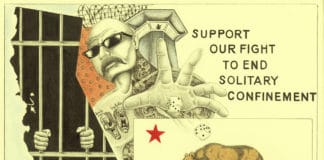Tags Long-Term Solitary Confinement
Tag: Long-Term Solitary Confinement
Pelican Bay Hunger Strike: Four years and still fighting
Four years ago prisoners in California – led by those in the control units of Pelican Bay – organized a hunger strike to demand an end to the torturous conditions of solitary confinement. Two more strikes would follow, with over 30,000 prisoners taking united action in the summer of 2013 – both in isolation and in general population in nearly every California prison. Current prison organizing continues a historic legacy of struggle.
Four years since our hunger strikes began, none of our core...
We prisoners need to prepare for a massive peaceful protest and work stoppage if prison officials don’t change 1) The culture to which prisoners and their families are subjected: so much mental and physical torment; 2) End long term solitary confinement, as they promised; and 3) Implement our five core demands. Too many humans are suffering who don’t need to be suffering.
Prisoner Human Rights Movement: Agreement to End Hostilities has changed the...
I encourage all men and women prisoners to continue to press onward with our Agreement to End Hostilities through all corridors of state and county facilities. We are fighting for human justice. We call on all citizens to get involved with social change now. We shall not allow even Gov. Brown to destroy our faith in humanity. The Prisoner Human Rights Movement shall stand as ONE clenched fist in solidarity against CDCr oppression.
California’s savage system of confinement: An end to solitary is long...
Less than two weeks ago the United Nations Committee against Torture issued a report strongly criticizing the U.S. record on a number of issues, among them the extensive use of solitary confinement. While the U.S. uses long-term solitary more than any other country in the world, California uses it more than any other state. This practice is designed to break the human spirit and is condemned as a form of torture under international law.
CDCR’s new con game to undermine our class action suit
In order to successfully advance in each step of CDCR’s newly enacted Step Down Program (SDP), prisoners are expected to fill out and complete a series of thought policing or brainwashing workbooks. One such workbook is entitled “The Con Game” and purports to elucidate for the prisoner via “self-directed journaling” the ways in which he either consciously or unconsciously is a con artist and criminal.
When it comes to solitary confinement, U.S. fails the mice standard
Federal agency guideline on the use of solitary confinement: An individual should never be locked in solitary confinement, except as an absolute last resort. Individuals, when in isolated confinement, must have the ability to socialize, to communicate and to physically interact with other individuals. This would be great news for those of us working on solitary reform, except for one thing: this guideline doesn’t apply to humans; it applies to mice.
California transfers Pelican Bay SHU prisoners to general population despite calling...
It has been a few months since my release from 20 years of solitary confinement at Pelican Bay State Prison (SHU) to Step 5 of the Step Down Program (SDP). I thought I should pen this communique with an update on my travels from one place to another – the new location, experience, encounters and situations – as everything has unfolded.
Chess vs. checkers
Life is like a game of chess and checkers. Many of us play checkers. And many of us think we’re playing chess, but, in practice, we’re actually playing checkers. So it should be of no surprise to any of you when I say, most poor people play checkers, prisoners in particular. Now what does this analogy imply? Most people make decisions in life without thinking ahead or assessing the ramifications of their decisions, especially prisoners!
To celebrate the movement: The California prisoner hunger strike one year...
One year ago on July 8, 30,000 California prisoners refused meals and work assignments, beginning a 60-day hunger strike with the core demand of ending the state’s use of indefinite solitary confinement. This was the largest hunger strike in U.S. history, and it presented the deepest challenge yet to solitary by bringing national and international attention to a practice that has long been condemned by human rights groups as torture.
Attorney Anne Butterfield Weills: ‘Obscenity’ regs show ‘CDCR views many of...
The fact that these rules were noticed as “Obscene Materials” indicates an intention of CDCR to attempt to fly below the radar so as to not draw attention to the fact that much of the material under these proposed regulations could be so broad as to cover newspaper articles and a multitude of other written materials that do nothing to promote prison safety and security and do everything to violate and infringe on the First Amendment rights of California’s prisoners.
California moves to curb solitary confinement
Following a mass hunger strike by prisoners in California last year, some state legislators promised to reform the use of Security Housing Units (SHU). This week, Assembly Bill 1652, passed the Assembly Public Safety Committee. It now heads to the Assembly Appropriations Committee. If the bill becomes law, prisoners would only be sent to SHU for specific serious rules violations that come with determinate SHU sentences.
Security Threat Group policy is sugarcoated racial profiling aimed at torture
The experimental Security Threat Group (STG) gang identification policy is not what CDC is making it out to be. It’s a sugarcoated form of racial discrimination and racial profiling to cover their ass in torturing human beings in California’s isolation units.
An end to ‘the hole’? 6 signs that solitary confinement reform...
Roughly 80,000 people are held in solitary in the United States on any given day, according to the Bureau of Justice Statistics, in many cases for minor violations of prison rules (or no violation at all – ed.). Much of the momentum in the movement to reform the use of solitary confinement in the United States comes from the work of prisoners themselves.
Seven months after historic California prison hunger strike, opponents of solitary...
Tomorrow, California lawmakers will hold a hearing about the use of solitary confinement inside its state prison system. February marks seven months since people incarcerated throughout California embarked on the mass hunger strike that has drawn legislative attention to prison conditions. The CDCR released new proposed regulations around its gang policies, and it points to changes already made. Accounts from former hunger strikers suggest that change is slow in coming.
Women in solitary confinement: ‘The isolation degenerates us into madness’
A mass prisoner hunger strike rocked California’s prison system this past summer, drawing international attention to the extensive use of solitary confinement in the United States. Nearly all of the attention, however, has focused on solitary confinement in men’s prisons; much less is known about the conditions and experiences inside women’s prisons.
Our own political action committee can expand the prisoners’ rights movement
I was pleased to read about the current talk of creating a political action committee (PAC) for prisoners. There was a time when I despised the whole oppressor political apparatus, but I was lucky enough to have comrades who explained that there is nothing wrong with being involved in local politics because these are the ways that we can transform our communities at the current stage in our struggle.
To all the homies on lock and solitary
California has my full support on all their endeavors, a great accomplishment you all rode and continue to ride against CDC. Maybe one day the sleeping giants of Georgia will follow suit. The West was won by the last ones standing. Your fight is all our fight. I say everybody on lock should join this one by any strategic method possible. You all stay up!
For honorable men confined to cages
In this journey of life, betrayal is all I’ve known. As I stand alone in my concrete home, time reveals wounds unhealed. The reasons for my seething have grown. I now see not just my own; the face concealed behind the mask is shown, the taskmasters’ cover is blown. He is the past, persistent grasp who by hoax, coax or lash cast us in the mold of his sculptor’s craft. As we destroy ourselves, the architects laugh.
Herman Wallace, who gave his life to end solitary confinement, got...
For 41 years, Herman Wallace was shown no mercy by a system that has never shown any mercy to anyone it considers its historical or present enemy. Herman Wallace was made to suffer at the hands of local, state and federal governments. No matter how bad his situation got, there was not one human being within this system, or government, who sought to provide Herman Wallace any mercy.
Confronting California’s abuse of solitary
Solitary confinement can eat away at someone’s mind, making mental illness worse and leaving many people depressed, suicidal, hopeless or hallucinating. It’s no place for individuals with mental illness. In 1995, a federal court in California agreed. After a trial exposing the appalling conditions at Pelican Bay, a federal judge ordered all mentally ill prisoners out of the prison’s security housing unit (SHU) in a case called Madrid v. Gomez.

 Store
Store








